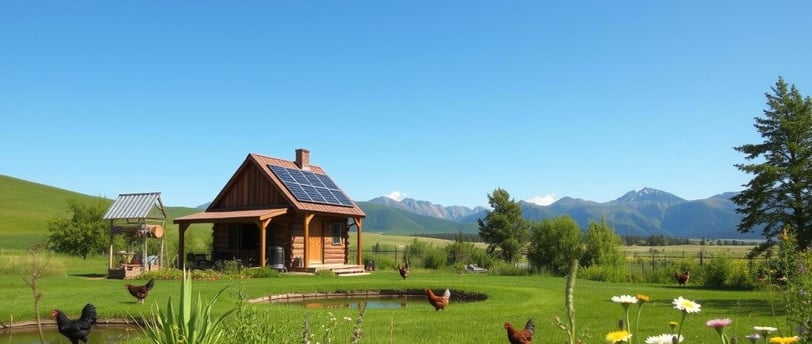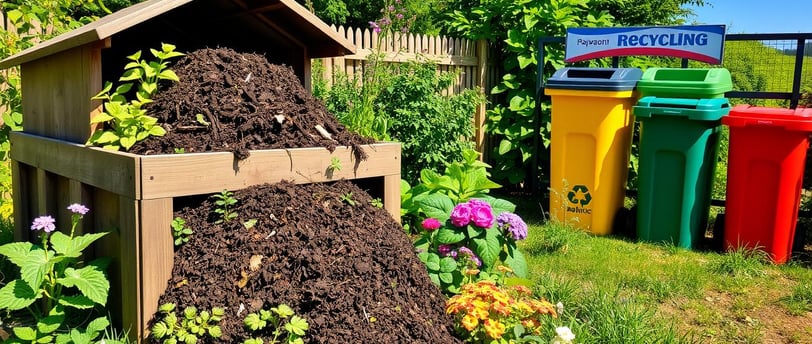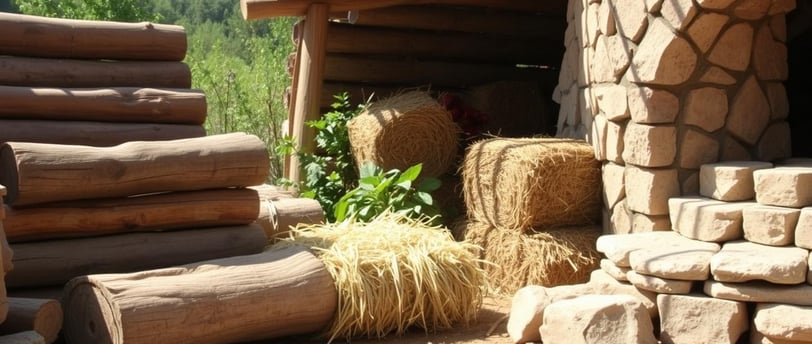Self Sufficient Off Grid Living: A Sustainable Choice
Explore the benefits and challenges of self-sufficient off-grid living. Learn practical tips for sustainable energy, water management, food production, and waste reduction to achieve independence from traditional utilities.
The Bug Out Bunker
8/30/202412 min read


Did you know over 1 million Americans now live off-grid?
They're choosing a sustainable, self-sufficient life.
This shift is more than a trend. It's a movement for more freedom, caring for the planet, and feeling closer to nature.
This guide will show you how to live off-grid. We'll cover using renewable energy, building smart homes, growing your own food, and saving resources. Learn how to face challenges and enjoy the benefits of a sustainable life that matches your values.
Key Takeaways
Understand the benefits and considerations of self-sufficient off-grid living
Identify the right location and evaluate the landscape and climate for your off-grid home
Explore renewable energy solutions, including solar power and wind power, to achieve energy independence
Learn effective water management strategies, such as rainwater harvesting and storage
Discover techniques for cultivating food self-sufficiency and sustainable waste management
Choosing the Right Location
Finding the perfect spot for your off-grid life is key. It means looking at the land and climate, and understanding the laws. This choice sets the stage for your off-grid dream home.
Evaluating the Landscape and Climate
Look for a spot with good solar, wind, and water power. Think about how to use the sun, wind, and water for energy. Use materials that last long and are good for the planet to handle the weather.
Getting water right is important, as is dealing with waste in an eco-friendly way. By looking at the land and weather, you can make a home that fits well with nature.
Legal and Regulatory Considerations
Dealing with zoning laws, building codes, and permits is a big part of off-grid living. It's important to know the rules to make sure your home is legal and safe. Get all the needed permits and follow health and safety rules.
Talking to local authorities early can make things smoother. It helps you live off-grid without trouble. By thinking about the laws early, you can build your home with confidence.
"The right location is the foundation of a successful off-grid lifestyle. By carefully considering the landscape, climate, and legal requirements, you can design a self-sufficient haven that thrives in harmony with the natural world."
Energy Independence: Harnessing Renewable Sources
Living off-grid means using renewable energy wisely. It's about designing solar power systems and checking out wind power potential. Each step is key to being energy independent and sustainable.
Solar Power Installation
First, you need to figure out how much energy you use every day. Then, design a solar system that fits your needs. Choose the right solar panels and arrange them to get the most sun.
Adding batteries and a charge controller helps store and manage the energy. A good solar setup meets your energy needs and cuts ties with the main power grid. Keep your solar panels clean and adjust their position with the seasons to boost their performance and make them last longer.
Wind Power Potential
Looking into wind patterns and feasibility is crucial for off-grid living. Know the wind speeds and directions in your area to place wind turbines right. Wind turbines are great for using a clean energy source and lowering your carbon footprint.
But, they have some downsides. You need to pick the right spot and check the wind conditions. Inconsistent winds can lower energy production. There are also maintenance needs and noise issues to consider. Still, wind turbines can be a big help in an off-grid energy plan.
"Harnessing renewable energy is the key to achieving true energy independence and sustainability in off-grid living."
Constructing an Off-Grid Dwelling
Tiny homes are the best choice for off-grid living. They use less energy and water, making them great for self-sufficient living. These homes are also easy to heat and don't take up much land.
To keep things energy efficient and sustainable, focus on using space wisely. Use vertical space, smart storage, and features that change for different needs. A simple kitchen setup also helps keep things efficient.
Using passive solar design and good insulation makes homes better at keeping warm or cool. Materials like cob, brick, tiles, or concrete help with this. This approach makes the home energy-efficient and uses eco-friendly building materials.
"The beauty of a tiny home lies in its ability to provide a comfortable, self-sufficient living space while minimizing its environmental impact."
Think about the site's landscape and climate when building your tiny home for off-grid living. This way, you can use natural resources and lower your carbon footprint. This approach to energy-efficient home construction helps achieve a sustainable lifestyle off the grid.
"sustainable off grid home design" https://ecoshack.com/off-grid-oasis-anderson-architecture/
Mastering Water Management
Getting clean, reliable water is key to off-grid living. There are many ways to manage water well, making sure you have enough for your self-sufficient life.
Rainwater Harvesting and Storage
Rainwater harvesting is a smart choice. By putting gutters on your home and directing the water to tanks, you can save rainwater for drinking, cooking, and gardening. This method gives you a steady water supply, even in places with little rain.
For safe water, you need a simple DIY filter. Use natural stuff like sand and charcoal to clean out dirt, bacteria, and other bad stuff. This makes sure your water is clean and safe to drink.
If rainwater isn't enough, you might want to dig a well. But, think about the soil, how deep the water is, and what might pollute it. This way, you can be sure the water is good and safe for your off-grid home.
Using a good water management plan can mean rainwater harvesting, filtering, and digging wells. This way, you can have a steady and safe water supply for your off-grid life.
Cultivating Food Self-Sufficiency
Living off the grid means having a steady food supply is key. By growing your own organic garden and raising animals, you can get fresh produce and meat. Foraging for wild plants adds variety and nutrition to your meals.
Learning how to preserve and store food is vital. Techniques like canning, dehydrating, and root cellaring keep your harvest fresh all year. This cuts down on buying food from others and lets you enjoy your hard work longer.
Start an organic vegetable garden with a variety of fruits and vegetables.
Keep chickens or other small animals for eggs and meat.
Forage for wild plants like mushrooms, berries, and greens to make your meals healthier.
Learn to preserve food with canning, dehydrating, and root cellaring to keep your food fresh longer.
"Self-sufficiency in food production is the first and most important step towards true independence."
By using organic gardening, raising animals, and foraging, you can create a self-sufficient food system. This approach gives you a steady food supply and connects you with nature. It makes you feel more independent and in tune with the earth.
Waste Management Solutions
Living off-grid means taking care of your waste. You can do this by composting organic waste and turning it into soil for your garden. Also, recycling and reusing materials helps cut down on waste, making your off-grid life more sustainable.
Composting and Recycling Strategies
Composting is key for waste management for off grid living. Create a spot for composting and add different organic stuff. This makes a circle where your garden grows and you don't need outside fertilizers. It's good for your garden and cuts down on waste.
Recycling is also vital for off grid waste disposal. Sort and reuse things like glass, metal, and plastic to reduce waste. Look for recycling options or make your own to give old materials a new life, not the landfill.
Set up a spot for composting to recycle organic waste
Add various materials like food scraps and yard clippings to make soil
Check out recycling programs or make your own for non-organic stuff
Try to reuse and repurpose items to lessen waste
Using composting systems and recycling off grid can greatly reduce your waste. This helps make your off-grid life more eco-friendly.
"building a sustainable house" https://ecoshack.com/how-to-build-a-sustainable-house/



self sufficient off grid living: A Holistic Approach
Living off-grid in a holistic way is key for a balanced life. It means blending different systems for energy, water, food, and waste. Being flexible and ready to change is important, as off-grid living needs you to adjust to nature's cycles.
Thinking big and always improving your way can make off-grid living better. This holistic approach helps you balance what's important. It guides you in making choices that help you live off-grid for the long term.
Starting or adjusting to off-grid life? A holistic mindset is vital. By blending systems and staying flexible, you can live off-grid in a way that fits your values and needs.
"The key to successful off-grid living lies in embracing a comprehensive, adaptable approach that nurtures harmony between your lifestyle and the natural environment."
Seamlessly integrate energy, water, food, and waste systems for a self-sufficient off-grid lifestyle
Maintain a flexible, adaptive mindset to balance priorities and adjust to lifestyle changes
Adopt a holistic perspective to cultivate a resilient, harmonious off-grid existence
Backup Power Options
Renewable energy like solar and wind power is key for off-grid living. But, having backup power is also vital. Generators can help when there's not enough renewable energy or if there are sudden power cuts. Also, energy storage systems, like batteries, can fill power gaps and keep electricity flowing smoothly. Adding these backups makes your off-grid life more resilient and self-sufficient.
For backup power for off-grid living, you need generators and energy storage. Generators start when there's a power outage or when renewable energy isn't enough. They ensure your important systems keep working until renewable energy comes back.
Portable generators are great for off-grid homes, giving you power in emergencies or when you need it most.
Bigger, installed generators can power your whole off-grid home, making them a strong backup.
Energy storage systems, like battery banks, store extra renewable energy when it's available. This stored energy helps when your renewable sources aren't enough, keeping your electricity supply steady.
"Integrating backup power options is a crucial step in achieving true energy independence and self-sufficiency in off-grid living."
By adding generators and energy storage to your off-grid plan, you get the best of renewable energy and a secure power supply. This way, you're ready for any unexpected power issues or low renewable energy times.
Natural Building Materials and Insulation
Building an off-grid home with natural and sustainable materials is key to living self-sufficiently. Using materials like straw bale, cob, or earthbag reduces environmental harm and uses the materials' natural insulation. This makes the home more energy efficient.
Combining eco-friendly construction methods with sustainable insulation techniques improves the home's thermal performance. Using recycled or plant-based insulation adds to the home's sustainability. Bioconstruction focuses on renewable and biodegradable resources for a self-sufficient, eco-conscious home.
"Sustainable living is about more than just renewable energy - it's about creating a harmonious relationship between our homes and the natural world."
Choosing natural building materials for off grid homes and sustainable insulation techniques helps reduce carbon emissions. It also leads to comfortable, energy-efficient, and eco-friendly living.
"eco-friendly home improvements " https://ecoshack.com/sustainable-living/


Eco-friendly and Sustainable Choices
Straw bale construction: Uses straw for walls that are energy-efficient.
Cob building: A mix of clay, sand, and straw for strong, stable structures.
Earthbag construction: Bags filled with soil or natural materials for walls.
Recycled and plant-based insulation: Reduces waste and uses natural resources.
By using eco-friendly construction methods and sustainable insulation techniques, homeowners can build off-grid homes. These homes are not only good for the environment but also comfortable and energy-efficient.
Integrating Renewable Energy Systems
Creating a strong off-grid energy system means combining different renewable sources like solar, wind, and hydroelectric power. This mix makes your energy supply more reliable and steady. It also lessens the effect of changes in each energy source.
It's important to size and set up these systems right. Adding energy storage and smart management strategies is key. This way, your off-grid home gets power from a flexible and green energy system. You'll have a steady and eco-friendly power source.
Integrate solar, wind, and hydroelectric systems for a diverse energy mix
Implement energy storage solutions to enhance reliability and consistency
Develop effective management strategies to optimize renewable energy production
"Integrating renewable energy systems is key to achieving true off-grid self-sufficiency. By harnessing the power of nature, you can create a resilient and sustainable energy ecosystem for your home."
With the right planning and setup, you can make the most out of off-grid living. You'll get to enjoy the benefits of being energy independent.
Building a Self-Sustaining Community
Creating a thriving off-grid community boosts the benefits of living off the grid. By joining with others who share your goals, you can share resources and knowledge. This helps everyone improve their off-grid life.
At the center of a self-sustaining community is sharing resources. Pooling tools, skills, or food can make a strong, resilient group. Sharing reduces costs and builds a strong connection among community members.
Off-grid communities also look into new ways to trade like bartering and community currencies. These methods cut down on traditional money use and support a fair, self-sufficient life. By using these systems, you meet your needs and grow closer to your community.
Building connections is key to a successful off-grid community. By working together and sharing skills, you create a strong support network. This community support improves your life and makes your off-grid living more resilient.
Embracing off-grid community development opens up new possibilities for a fulfilling life. Sharing resources, exploring new economies, and building connections lead to a vibrant, sustainable community. This community becomes a model for living well off the grid.
Conclusion
Starting your journey to self-sufficient off-grid living is a big step. It changes your life in many good ways. You'll learn to live in harmony with nature and sustainably.
Think about the key parts of this lifestyle. This includes picking the right place, using renewable energy, growing your own food, and handling waste well. These steps help you build a strong and happy off-grid life.
Success comes from seeing the big picture. Blend different systems and strategies together. Be ready to adjust to nature's changes. You can join a community or create your own off-grid home. This path offers more freedom, care for the earth, and a deep bond with nature.
As you move forward, remember the big benefits of off-grid living. It's not just about being self-sufficient. It's about helping the planet and inspiring others. With hard work, flexibility, and a strong vision, you can make a remarkable off-grid life. This life will show others how to live more independently and eco-friendly.
FAQ
What are the key considerations when choosing the right location for off-grid living?
Choosing the right spot for off-grid living means looking at the landscape, climate, and laws. You need to check the area's potential for solar, wind, and hydroelectric power. It's also important to design your home with passive solar design and use sustainable materials. Make sure to follow the local building codes and zoning laws to make your off-grid home legal and possible.
How do I accurately calculate my energy needs and design an efficient solar power system for off-grid living?
First, figure out how much energy you use every day and how it changes with the seasons. Then, pick solar panels that can meet your energy needs. Use batteries and a good charge controller to keep your solar power steady and reliable.
What are the benefits of incorporating wind power into an off-grid energy strategy?
Using wind turbines can be a big plus for off-grid energy. They use a renewable energy source, which is good for the planet. But, you need to pick the right spot for the turbine and think about maintenance and noise.
Why are tiny homes the most logical choice for off-grid living?
Tiny homes are great for off-grid living because they use less land, energy, and water. They're easy to heat and cool with smart design and materials. This makes them a smart choice for a sustainable lifestyle.
How can I ensure a consistent and clean water supply for my off-grid lifestyle?
Getting clean drinking water is key for off-grid living. Use rainwater collection systems and a simple filter to keep the water safe. If rainwater isn't enough, you might need to dig a well.
What strategies can I implement to achieve food self-sufficiency in an off-grid setting?
Grow your own food and raise animals like chickens for eggs and meat. Foraging for wild plants adds variety to your meals. Learn to preserve food to keep your harvests going all year.
How can I effectively manage waste in an off-grid lifestyle?
Managing waste well is key for a green off-grid life. Use composting to turn waste into soil for your garden. Also, reuse and recycle materials to cut down on waste and live more sustainably.
What are the benefits of incorporating backup power options into an off-grid energy system?
Even with solar and wind power, having backup options is smart. Generators help during low energy times or outages. Batteries store extra power for when you need it, making your off-grid life more reliable.
How can I incorporate natural and sustainable building materials into the construction of my off-grid dwelling?
Using natural and sustainable materials for building is important for a self-sufficient home. Choose eco-friendly options like straw bale or earthbag construction. Add insulation with recycled or plant-based materials for better energy efficiency.
How can I foster a self-sustaining community to amplify the benefits of off-grid living?
Building a community around off-grid living helps a lot. Share resources and knowledge with others to improve everyone's self-sufficiency. Bartering and supporting each other creates a strong, supportive network for a better off-grid life.
Source Links
Mastering Off-Grid Living: Essential Tips For A Sustainable Lifestyle | The Off Grid Cabin
How to live off the grid: the ultimate guide for beginners (2023)
Source Links
Building a self sufficient homestead
Building a survival shelter
Thanks and best regards
The Bug Out Bunker
Visit the link below and Purchase your Emergency 250 Survival Kit Backpack
This post may contain affiliate links. If you make a purchase through one of these links, we may earn a small commission at no additional cost to you. We only recommend products and services that we have personally used and believe will add value to our readers. Your support helps us continue to provide valuable content. Thank you for your support!
Survival
Stay prepared for any scenario with our expert insights.
© 2024. All rights reserved.
